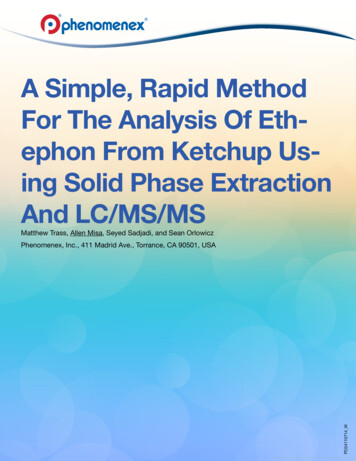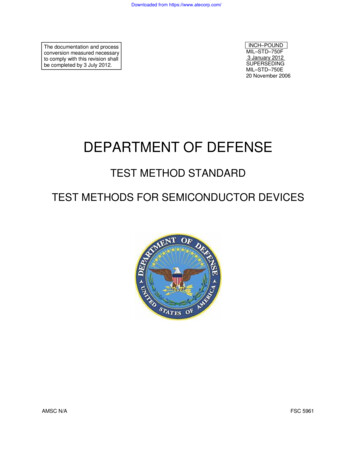
Transcription
A Simple, Rapid MethodFor The Analysis Of Ethephon From Ketchup Using Solid Phase ExtractionAnd LC/MS/MSMatthew Trass, Allen Misa, Seyed Sadjadi, and Sean OrlowiczPO24110714 WPhenomenex, Inc., 411 Madrid Ave., Torrance, CA 90501, USA
Figure 1. Parent StructureClOHPEthephon (MW 144.49)Log KOW -2.2 (25 ºC)OOH
Materials and MethodsHPLC analysis was performed using a Shimadzu Nexera HPLC (Shimadzu, Columbia, Maryland 21046 U.S.A). LC/MS/MS analysis was performed using an AB SCIEX API 4000 QTRAP System (AB SCIEX, Framingham, MA). Solidphase extraction use of Phenomenex Strata -X-AW (Part No. 8B-S038-ECH) followed by the use of Luna 3 µm NH2(Part No. 00B-4377-B0) from Phenomenex, Torrance, CA, USA. All chromatographic conditions are as specified on theindividual figures.
Figure 2. Sample PreparationSolvent Extraction:1.2.3.4.5.6.Weigh and transfer 2 g of ketchup into a 15 mL centrifuge tubeAdd 2 mL of 100 mM Sodium phosphate bufferAdd 10 mL of Acetone and vortex until ketchup is dispersedShake using mechanical shaker for 4 minCentrifuge at 6000 rpm or greater for 4 minSupernatant is ready for loading onto SPE cartridgeSolid Phase Extraction:Cartridge:Part. No.:Condition/Equilibrate:Load:Wash :Dry:Elute:Blow down:Strata-X-AW 100 mg/6 mL8B-S038-ECH3 mL of AcetoneSupernatant from solvent extraction3 mL of Methanol3 min at high vacuum ( 10 in. Hg)3 mL of Methanol with 1 % TFADry sample under nitrogen at 50 ºCNote: Reconstitute sample with 0.5 mL of Acetonitrile/ Water (9:1) and transfer to an autosampler vial for LC/MS/MS analysis
Figure 4. Calibration curve5.2e55.0e5R2 0.99994.8e54.6e54.4e54.2e54.0e53.8e53.6e5Analyte 0200250300350400450500550Concentration, ng/mL6006507007508008509009501000Ethephon matrix-extracted calibration curve (5-1000 ng/g), R2 0.9999At the low end of the calibration curve (5 ng/g) the S/N ratio is 16.5. This value corresponds to a LLOQ of 3.0 ng/gand a LLOD of 0.9 ng/g (Based off of commonly accepted S/N target values for LLOQ and LLOD of 10 and 3respectively).
Figure 3. Chromatograms319Ethephon extract from ketchup at50 ng/g (110th injection)5000.00App ID 22676Intensity, .54.04.5min324Ethephon extract from ketchup at250 ng/g2.0e51.0e5App ID 22677Intensity, cps3.0e50.00.5Column:Dimensions:Part No.:Mobile Phase:Gradient:1.01.5Luna 3 µm NH250 x 2.0 mm00B-4377-B0A: 10 mM Ammonium bicarbonate pH 10B: AcetonitrileTime(min)B (%)0.0905.0102.0Flow Rate:Inj. Volume:Temperature:Detection:Sample:2.53.00.4 mL/min10 µLAmbientAPI 4000 QTRAP (AB SCIEX) Tandem Mass Spec (MS/MS)Ethephon extract from ketchupNote:Mrm : Ethephon 142.8 106.9/35Valco Valve:Time (min) Flow direction0 2.5 Waste2.5 4.0 MS4.0 8.0 WasteTFA in the ion-source can significantly reduce MS intensity. It is recommended that a divertervalve is utilized to ensure that no residual TFA from the SPE step is transferred to the MS.
Results and DiscussionIn this study, we present a fast, simple, and sensitive method for the analysis of ethephon residues in tomato ketchup.Ethephon is first extracted from the ketchup matrix witha simple solvent extraction using acetone and sodiumphosphate buffer. The extract is then cleaned up usingion-exchange SPE. As shown in Figure 1, the phosphatefunctionality of ethephon lends itself perfectly to extractionwith Strata-X-AW allowing a strong 100 % methanol washwithout loss of analyte. The strong wash removes a largeamount of matrix contamination, resulting in a very cleanextract.The SPE extraction alone yields a high 80.1 % recovery(Table 1). However, the solvent extraction prior to SPE hasa low extraction efficiency resulting in a 14.2 % total method recovery. In order to increase the solvent-extraction efficiency several variables were tested including extractiontime, extraction solvent, pH, and solvent molarity. However,the extraction efficiency was not improved. We think thecause of the low solvent-extraction efficiency is related toprotein-binding with the phosphate moiety of the ethephonmolecule.Following SPE, the resulting sample is then analyzed using a high-pH LC/MS/MS analytical method on an amino-type stationary phase (Luna 3 µm NH2). The pH gradient used (Figure 3) focuses the analyte on the stationaryphase before elution, resulting in a narrow peak-shapeand a retention time away from the ion-suppression region(Figure 3). Due to the excellent peak shape and highSPE recovery, low limits of detection and quantitation areachieved, despite the poor solvent-extraction efficiency.The extrapolated LLOQ and LLOD are determined to be3 ng/g and 0.9 ng/g, respectively. In addition to the low detection limits, the method achieved a calibration curve linearity value of R2 0.9999 (Figure 4)One drawback of the high-pH mobile phase used on theamino-type stationary phase is that the column’s lifetime isshortened relative to conventional reversed phase methods.Therefore, it is recommended that the stability of the columnand the resulting chromatography is monitored over time,especially as the column approaches 200 or more injections. However, as shown in Figure 3, after 110 injectionsthe chromatographic performance has not degraded.
Table 1. RecoveryEthephon concentrationRecovery %Strata-X-AW Recovery*80.1Total Method Recovery**14.2*Strata-X-AW recovery is calculated by spiking ethephon standard into a solvent-extracted matrix blank prior to SPE**Total method recovery is calculated by spiking ethephon standard directly into the ketchup matrix prior to solventextraction and SPE extraction
ConclusionsEthephon analysis using conventional analyticaltechniques is challenging due to the polarity ofthe molecule as well as the complex matricesthat are being tested.Using ion-exchange SPE effectively removesa large amount of interferences from a tomatoketchup matrix. The cleaned-up sample resultsin a clean LC/MS/MS baseline, allowing maxi-mum sensitivity with limited ion suppression.Following SPE, excellent retention and peakshape were obtained using Luna NH2 with ahigh-pH mobile phase. Whereas, trials on typical reversed phase or HILIC-mode conditionsresulted in either insufficient retention or severetailing.TrademarksKinetex is a registered trademark of Phenomenex. Mitra and VAMS are trademarks of Neoteryx, LLC. Sartorius is a registered trademark of Sartorius AG. Whatman and FTA areregistered trademarks of GE Healthcare Companies. API 3000 is a trademark of AB SCIEX Pte.Ltd. AB SCIEX is being used under license. 2014 Phenomenex, Inc. All rights reserved.
References1. Takenaka S; Journal of Agricultural and Food Chemistry. 50: 7515-7519 (2002)TrademarksLuna is a registered trademark and Strata-X is a trademark of Phenomenex. API 4000 is a trademark and QTRAP is a registeredtrademark of AB SCIEX Pte. Ltd. AB SCIEX is being used under license. Shimadzu and Nexera are registered trademarks ofShimadzu Corporation. 2014 Phenomenex, Inc. All rights reserved.
In this study, we present a fast, simple, and sensitive meth-od for the analysis of ethephon residues in tomato ketchup. Ethephon is first extracted from the ketchup matrix with a simple solvent extraction using acetone and sodium phosphate buffer. The extract is then cleaned up using ion-exchange SPE. As shown in Figure 1, the phosphate











